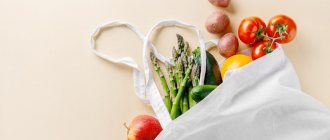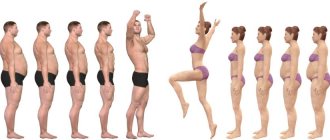Why is obesity dangerous?
First of all, because obesity is the basis for the development of many diseases. These are diabetes mellitus, atherosclerosis, lipid (fat) metabolism disorders. The complex of changes that occurs in the body of a person suffering from excess weight leads to the development of hypertension, atherosclerosis and coronary heart disease.
In addition, obesity can cause gynecological problems. The female reproductive system is very sensitive to the influence of hormones secreted by adipose tissue. Against the background of obesity (especially abdominal obesity, when the main reserves are concentrated in the abdominal area), a disorder of carbohydrate metabolism such as insulin resistance . Insulin resistance is the body's insensitivity to the action of its own insulin, which is responsible for glucose metabolism. Insulin resistance is the cause of the development of polycystic ovary syndrome . And for a woman this means irregular menstrual cycles, acne, hirsutism and even infertility. In older women, menopausal metabolic syndrome , which includes carbohydrate metabolism disorders including diabetes mellitus, hypertension, coronary heart disease and lipid metabolism disorders.
Excess weight is also dangerous for a pregnant woman. Such a pregnancy, as a rule, occurs with complications for both the mother and the unborn child. Obese pregnant women are more likely to experience miscarriage, the development of gestational diabetes mellitus, preeclampsia, infections of the genitourinary system and complications during childbirth. The child has a significantly increased risk of developing congenital malformations. For example, if the body weight before pregnancy exceeded 80 kg , then the risk of neural tube defects in the fetus increases 2 times, and if a woman weighed more than 110 kg , then 4 times.
Fetal macrosomia, intrauterine growth retardation, and an increased incidence of birth trauma in newborns are all complications characteristic of obese pregnant women.
How to determine if you are overweight?
There is a fairly simple formula that is used by doctors all over the world. This is the body mass index (BMI). The index is calculated in three stages.
- Measure your height in meters and square that number.
- Measure your weight in kilograms.
- Divide your weight (in kilograms) by the square of your height (in meters)
Example: Your height is 1.68 m . m2 = 1.681.68 = 2.82.
Example: Your weight is 62 kg .
Example: 21.9 kg/m2
Normal BMI values are those that fall within the range from 18.5 to 24.9. A BMI from 25 to 29.9 is considered overweight, and a BMI greater than 30 is considered obese.
In addition to BMI, the most important indicator for health is waist circumference . Waist circumference is measured with a measuring tape midway between the bottom edge of the ribs and the top edge of the pelvic bone (as shown in the picture). The measuring tape should lie strictly horizontally and should not cut into the skin. Waist circumference allows you to judge the deposits of internal, abdominal fat.
Abdominal circumference in women greater than 80 cm , and in men greater than 94 cm is a risk factor for the development of diabetes mellitus, lipid metabolism disorders, and hypertension. In addition, it is a marker of insulin resistance , which may cause the development of polycystic ovary syndrome and associated infertility and cycle disorders.
Guessing by wrist
This method is also elementary, but unfortunately, even less accurate than the experiment with waist size. Still, if you are worried about how to quickly find out your weight without a scale, then your wrist and height will help you. By the way, you don’t even need a measuring tape here, which makes this calculation option even more convenient.
So, grab your wrist so that your thumb and index finger are loosely connected. If this trick was successful without difficulty, then you are one of the asthenics - people with a slender physique. In this case, the formula for calculation is as follows: (height - 100) - (height x 0.1) = your approximate weight.
For example, you were able to connect your fingers on your wrist, and your height is 168 centimeters. We count: (168 – 100)—(168 x 0.1)=51.2 kilograms. But this formula only works for this body type and only if there are no visible problems with excess weight.
People who cannot clasp their wrist freely need to calculate their weight a little differently: (height - 100) + (height x 0.1) = your approximate weight. In an example, it looks like this: (168 – 100) + (168 x 0.1) = 84.8 kilograms. As you can see, the difference is noticeable, so it is important to approach the wrist measurement honestly and remember that the finger ring should be loose.
How to change your lifestyle?
Unfortunately, there is no miracle method for losing excess weight. Surgeries and drug therapy are all just assistants on the path to weight loss that have a temporary effect. Obesity occurs due to consuming more calories than the body needs, and therefore the only treatment is to change this situation.
Lifestyle changes are based on two pillars: eating a sensible diet and increasing physical activity. Don’t try to start a new life “on Monday” - move towards your goal gradually, achieving new results every day.
Think and write what goals you need to achieve. Don't try to immediately lose weight to your ideal weight. At the first stage, try to reduce your weight by 5-10% of the original, remember that rapid weight loss is no less dangerous to health than obesity.
Nutrition.
Some tips to help you cope with obesity.
- Try to eat more often. Yes, it sounds ambiguous, but the most favorable diet for the body is one that includes 3 main meals (breakfast, lunch, dinner) and two additional ones. Remember that your last meal should be at least 2 hours before bedtime. Nutritionists recommend consuming at least 1200 kcal per day. If you are used to eating more, reduce your daily caloric intake gradually.
- Eat slowly and enjoy your food. The saturation signal takes about 15 minutes to reach the brain. The slower you eat, the less you will eat, because the signal of fullness will have time to arrive in time.
- Drink enough water. The average fluid intake is eight glasses per day. Avoid sweet, carbonated drinks and soft drinks. Choose water with lemon, tea or coffee without sugar.
- Your diet should contain approximately 30% fat, 55 - 60% carbohydrates and 15% protein. Be sure to eat green vegetables and fruits every day. Eating vegetables as a snack before the main course will help reduce the number of calories you eat.
- Watch the calorie content of your foods. Please see the label for complete nutritional information. Try to eat as little food as possible that is high in fat and calories, that is, limit the amount of the following foods.
Products containing a lot of fat (including hidden fat).
- Vegetable, ghee and butter, margarine, mayonnaise.
- Sauces and gravies.
- Nuts, sunflower seeds, olives.
- Fatty fish and meat.
- Smoked products, canned food (especially in oil).
- Cream, sour cream, fatty varieties of cottage cheese and cheese (with a fat content of more than 30%, including processed cheeses, sweet cheeses, curd masses).
- Sausages.
Foods containing easily digestible carbohydrates (that is, containing many calories).
- Sugar and sugar-containing products: chocolates, pastries, cakes, creams, ice cream (also containing a lot of fat).
- Dried fruits
- Grapes, bananas
- Choose foods rich in starch and fiber . These products include:
- Bread and cereal products containing bran or made from whole grains
- Durum wheat pasta
- Grains
- Fruits and vegetables
- When cooking, give preference to the grill, microwave or barbecue, do not add fat or oil. Use non-stick cookware and cook in foil. Trim visible fat from meat, and do not eat the skin of poultry or fish.
- Try to limit the amount of alcohol. Alcohol increases appetite, and, in addition, a lot of fatty and salty foods are eaten with alcohol.
- Keep a food diary. Regardless of whether you work with a doctor or try to monitor your weight yourself, a food diary will help you assess the quantity and quality of what you eat per day. Write down everything you eat and at the time you eat it, even if it's candy you grabbed on the run. In addition, note your weight and physical activity there.
- Think about it: do you always eat because you are hungry? Or do you eat away at troubles, anxiety and sadness? Or are you just having a snack for company? Try not to eat while watching TV.
- What to choose if you come to a restaurant?
- First, before going to a restaurant or visiting, have a light snack. Don't leave the house feeling hungry.
- Order grilled, stewed, baked, boiled or barbecued dishes.
- Avoid eating fried foods, crunchy foods, creamy or creamy sauces, cheese or cheese sauces. If you are not sure how a dish is prepared, ask the waiter. Please ask that the sauces be served separately. Give preference to boiled, stewed or grilled vegetables. To reduce portion size, you can order 2 types of appetizers instead of the main course. Take one dessert for two.
- Ask for skim milk in your coffee. Choose low-calorie drinks: water, tomato juice, soda, drinks with sugar substitutes, low-calorie beer.
- Take your time to eat the whole portion, eat slowly, enjoy your food.
- Try to think through your diet in advance. When creating a menu, use the food pyramid.
| Food group | Number of servings per day | Serving Size |
| Lean meat, poultry, fish and shellfish | 170 g or less | — |
| products made from low-fat milk (up to 2.5% fat content) | 2-3 | 1 cup milk 1 cup yogurt 28 g low-fat or low-fat cheese |
| Eggs | 4 yolks per week | — |
| Fats and oils (including salad dressings and nuts) | 6-8 | 1 tsp margarine or vegetable oil 1 tbsp. salad dressing 28 g nuts |
| Fruits | 2-4 | Whole fruit ½ cup chopped fruit ¾ cup fruit juice |
| Vegetables | 3-5 | 1 cup leafy or raw vegetables ½ cup cooked vegetables ¾ cup vegetable juice |
| Bread, cereals, rice, pasta, dry peas and beans, grains, potatoes | 6-11 | 1 slice of bread 28 g dry flakes ½ cup cooked group, dry peas or beans, potatoes, rice and other grains ½ cup tofu |
Archimedes' Law
This method is the most accurate of all the options for finding out your weight without a scale. But it is quite complex and is not suitable for everyone. The difficulty is that you will need to put in some effort and find the right tools.
So, according to Archimedes' law, any body that is immersed in a liquid will push it out exactly as much as the volume of the body itself. To translate this into accessible language, place yourself in a full bathtub or barrel, collect the water that spills out, and you will find out your weight. Of course, this method is unlikely to be suitable for an adult, but if you are tormented by the question of how to find out the weight of a child without scales, then Archimedes will help you.
Fill the baby bathtub to the brim and place your baby in it. Some of the water will definitely spill out. All that remains is to find out its volume. There are two ways to do this. The first is to collect the liquid in liter jars (conventionally taking 1 liter to be 1 kilogram). The second is, on the contrary, to fill the bath to the brim, counting how many liters are needed.
Physical activity
Dieting leads to weight loss. However, physical activity is indispensable in maintaining the achieved result. In addition, regular exercise helps reduce the risk of developing cardiovascular diseases. Start with light physical activity and gradually increase the intensity of your exercise.
For beginners, walking or swimming would be an ideal option. At the first stage, it is enough to exercise for 30 minutes 3 times a week. Gradually increase the training time to 45 minutes, and the number to 5 times a week. Replace an elevator ride with a stair climb, or one bus stop with a walk, and the number of calories burned will immediately increase. Exercise takes up your time, but it improves your well-being, protects your heart and brings pleasure.
Baby swing
You can find many more ways to find out your weight without a scale. But the most fun is the ordinary children's swing, which you need to ride on together. You will need the help of a friend or girlfriend, or better yet two. It is important that he or she knows exactly his or her weight. And this is done simply: carefully stand on the swing and slowly walk towards each other. Once both sides are level, one of the assistants should record the distance from each “weight” to the center. Next, we calculate using the formula: friend’s weight x (friend’s distance/your distance) = your weight.
These simple methods will tell you how to find out your weight without a scale. The BMI table will help determine whether this figure is normal. But it’s better to purchase the simplest mechanical scales and monitor your figure with an accuracy of grams.










